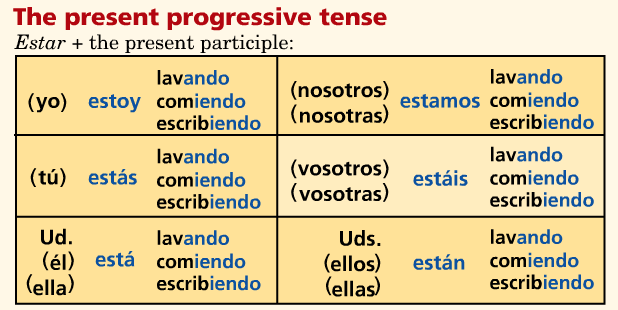In today's lesson, we will learn how to form and when to use the present progressive tense (also called the present continuos tense) in Spanish.
How to form the Present Progressive Tense
In English, the present progressive is formed by combining "to be" with the present participle ( -ing form of a verb). In Spanish, it is formed by combining a form of "estar" with the present participle.
So it is necessary to know how to conjugate the verb "estar" to agree with the subject of the sentence and how to form the present participle.
Estar conjugation
- Yo - estoy
- Tú - estás
- Ud., él, ella - está
- Nosotros/as - estamos
- Vosotros/as - estáis
- Uds., ellos, ellas - están
Regular present participles are formed as follows:
- -ar verbs: Add -ando to the stem of the verb (hablar - hablando, estudiar - estudiando)
- -er and -ir verbs: Add -iendo to the stem of the verb (comer - comiendo, hacer - haciendo)
- -ir stem changing verbs: Replace "e" with "i" or "o" with "u" in the stem and add -iendo to the stem of the verb (servir - sirviendo, decir - diciendo, poder - purdiendo, dormir - durmiendo)
- Sometimes, you need to change the spelling of a word so that it agrees with the way it is pronounced. This is called "orthographic" change. For examples: caer: cayendo, seguir: siguiendo, traer: trayendo

For examples:
Estoy hablando con mi madre - I am speaking to my mother
El abuelo está durmiendo en la sala - Grandpa is sleeping in the living room
Juan está comiendo pan - John is eating bread
Los niños están comiendo en el patio - The children are eating in the yard
See also:
When to use the present progressive tense in Spanish?
In Spanish, the present progressive tense is only used to describe an action that is happening now or an action that is "in progress."
For examples:
Estoy estudiando español - I am studying Spanish ((right now, at this moment)
María y Carmen están hablando con nosotros - Mary and Carmen are speaking with us
Unlike in English, the present progressive tense is not used for future actions. So you should never say something like "We are going to Spain this summer."
Follow our site to get instant Spanish to English translation, online Spanish dictionary, daily grammar, and vocabulary lessons.
